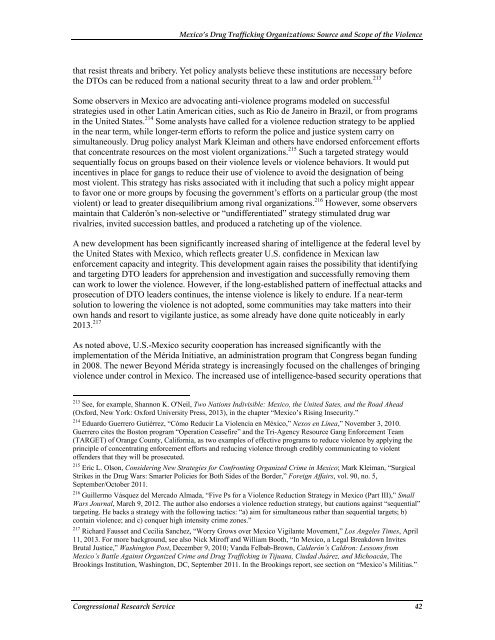Mexico's Drug Trafficking Organizations - Federation of American ...
Mexico's Drug Trafficking Organizations - Federation of American ...
Mexico's Drug Trafficking Organizations - Federation of American ...
You also want an ePaper? Increase the reach of your titles
YUMPU automatically turns print PDFs into web optimized ePapers that Google loves.
Mexico’s <strong>Drug</strong> <strong>Trafficking</strong> <strong>Organizations</strong>: Source and Scope <strong>of</strong> the Violence<br />
that resist threats and bribery. Yet policy analysts believe these institutions are necessary before<br />
the DTOs can be reduced from a national security threat to a law and order problem. 213<br />
Some observers in Mexico are advocating anti-violence programs modeled on successful<br />
strategies used in other Latin <strong>American</strong> cities, such as Rio de Janeiro in Brazil, or from programs<br />
in the United States. 214 Some analysts have called for a violence reduction strategy to be applied<br />
in the near term, while longer-term efforts to reform the police and justice system carry on<br />
simultaneously. <strong>Drug</strong> policy analyst Mark Kleiman and others have endorsed enforcement efforts<br />
that concentrate resources on the most violent organizations. 215 Such a targeted strategy would<br />
sequentially focus on groups based on their violence levels or violence behaviors. It would put<br />
incentives in place for gangs to reduce their use <strong>of</strong> violence to avoid the designation <strong>of</strong> being<br />
most violent. This strategy has risks associated with it including that such a policy might appear<br />
to favor one or more groups by focusing the government’s efforts on a particular group (the most<br />
violent) or lead to greater disequilibrium among rival organizations. 216 However, some observers<br />
maintain that Calderón’s non-selective or “undifferentiated” strategy stimulated drug war<br />
rivalries, invited succession battles, and produced a ratcheting up <strong>of</strong> the violence.<br />
A new development has been significantly increased sharing <strong>of</strong> intelligence at the federal level by<br />
the United States with Mexico, which reflects greater U.S. confidence in Mexican law<br />
enforcement capacity and integrity. This development again raises the possibility that identifying<br />
and targeting DTO leaders for apprehension and investigation and successfully removing them<br />
can work to lower the violence. However, if the long-established pattern <strong>of</strong> ineffectual attacks and<br />
prosecution <strong>of</strong> DTO leaders continues, the intense violence is likely to endure. If a near-term<br />
solution to lowering the violence is not adopted, some communities may take matters into their<br />
own hands and resort to vigilante justice, as some already have done quite noticeably in early<br />
2013. 217<br />
As noted above, U.S.-Mexico security cooperation has increased significantly with the<br />
implementation <strong>of</strong> the Mérida Initiative, an administration program that Congress began funding<br />
in 2008. The newer Beyond Mérida strategy is increasingly focused on the challenges <strong>of</strong> bringing<br />
violence under control in Mexico. The increased use <strong>of</strong> intelligence-based security operations that<br />
213 See, for example, Shannon K. O'Neil, Two Nations Indivisible: Mexico, the United Sates, and the Road Ahead<br />
(Oxford, New York: Oxford University Press, 2013), in the chapter “Mexico’s Rising Insecurity.”<br />
214 Eduardo Guerrero Gutiérrez, “Cómo Reducir La Violencia en México,” Nexos en Línea,” November 3, 2010.<br />
Guerrero cites the Boston program “Operation Ceasefire” and the Tri-Agency Resource Gang Enforcement Team<br />
(TARGET) <strong>of</strong> Orange County, California, as two examples <strong>of</strong> effective programs to reduce violence by applying the<br />
principle <strong>of</strong> concentrating enforcement efforts and reducing violence through credibly communicating to violent<br />
<strong>of</strong>fenders that they will be prosecuted.<br />
215 Eric L. Olson, Considering New Strategies for Confronting Organized Crime in Mexico; Mark Kleiman, “Surgical<br />
Strikes in the <strong>Drug</strong> Wars: Smarter Policies for Both Sides <strong>of</strong> the Border,” Foreign Affairs, vol. 90, no. 5,<br />
September/October 2011.<br />
216 Guillermo Vásquez del Mercado Almada, “Five Ps for a Violence Reduction Strategy in Mexico (Part III),” Small<br />
Wars Journal, March 9, 2012. The author also endorses a violence reduction strategy, but cautions against “sequential”<br />
targeting. He backs a strategy with the following tactics: “a) aim for simultaneous rather than sequential targets; b)<br />
contain violence; and c) conquer high intensity crime zones.”<br />
217 Richard Fausset and Cecilia Sanchez, “Worry Grows over Mexico Vigilante Movement,” Los Angeles Times, April<br />
11, 2013. For more background, see also Nick Mir<strong>of</strong>f and William Booth, “In Mexico, a Legal Breakdown Invites<br />
Brutal Justice,” Washington Post, December 9, 2010; Vanda Felbab-Brown, Calderón’s Caldron: Lessons from<br />
Mexico’s Battle Against Organized Crime and <strong>Drug</strong> <strong>Trafficking</strong> in Tijuana, Ciudad Juárez, and Michoacán, The<br />
Brookings Institution, Washington, DC, September 2011. In the Brookings report, see section on “Mexico’s Militias.”<br />
Congressional Research Service 42















